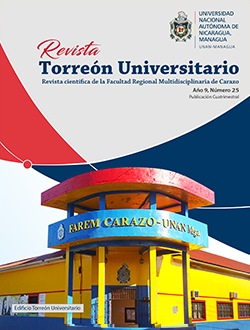Lead removal in aqueous solution using polyacrylamide-based cryogels as adsorbent: Balance study in batch mode
DOI:
https://doi.org/10.5377/torreon.v9i25.9855Keywords:
MPAAG-TBA Cryogels, removal, adsorption capacity, isotherms, Lead (Pb2 ), LeadAbstract
The objective of this research was to remove lead (Pb2+) ions from aqueous solutions using macroporos polyacrylamine gel (MPAAG) called cryogels as an adsorbent material. The MPAAG, were prepared by a free radical co-polymerization reaction of acrylamide (AAm) and allyl glycidyl ether (AGE) and N, N-methylene-bis (acrylamide) (MBAAm) bonded to epoxy functional groups (epoxy-pAAm) at a concentration of 7,5%, the reaction was carried out at -12 oC for 1 hour. After the preparation process, MPAAG was evaluated by binding the tris (2aminoethyl) amine (TREN) ligand groups followed by bromoacetic acid (BA). The presence of the amide and carboxyl group in the structure of the cryogels allowed the removal of lead to apply in aqueous solutions. The ability to remove lead on the MPAAG-TBA has been determined at different pH, metal concentrations and contact times. The technique used for the determination of lead in the aqueous solution was the Atomic Absorption Spectrophotometer (AAS). The maximum adsorption capacity of lead on the MPAAG-TBA was 10,78 mg/L at pH5 in 30 minutes. Adsorption equilibrium was performed at concentrations of 20,72; 41,44; 82,88 and 165,75 mg/L respectively of lead ions on the MPAAG-TBA results obtained were adjusted with the Langmuir and Freundlich model. The maximum adsorption capacity was determined by the Lagmuir model, the adsorption intensity (RL) values were lower than one, indicating that the adsorption of lead on the MPAAG-TBA is favorable; however it did not fit the model in the first two concentrations. The regression coefficient (R2) was used the Freundlich model and the intensity values (n) were found in the range of 1 to 10 considering the process of lead removal on the MPAAG-TBA was favorable. The results indicate that MPAAG-TBA criogels could be used as adsorbent material to remove ions Pb2+ present in aqueous solution at low concentration.
Downloads
Downloads
Published
How to Cite
Issue
Section
License
The authors who publish in this journal agree to the following terms.
- The author or authors of the articles, essays or research grant the National Autonomous University of Nicaragua, Managua (UNAN-Managua) the editing rights (copyright) of the submitted work, therefore the University has the exclusive right to publish the article for the entire copyright period.
- These copyrights/authors authorize Torreón Universitario Magazine and the University to edit and disseminate/publish the article in said Magazine, including printed and electronic reproduction, storage, retrieval and any other type of publication, and sources of secondary information as services. of summaries and databases, they also empower it to protect the article against unauthorized use for dissemination by printed or electronic media (PDF, HTML, EPUB, XML or others).
License for use of content
The magazine uses the Creative Commons Attribution-NonCommercial-NoDerivs 4.0 International License.
Under this statement:

This journal is licensed under a Creative Commons Attribution-NonCommercial-NoDerivatives 4.0 International License. It can be copied, distributed and transmitted publicly as long as the author and source are cited (Revista Torreón Universitario), it should not be modified or used for any commercial purpose. The full license can be found at http://creativecommons.org/licenses/by-nc-nd/4.0/.



